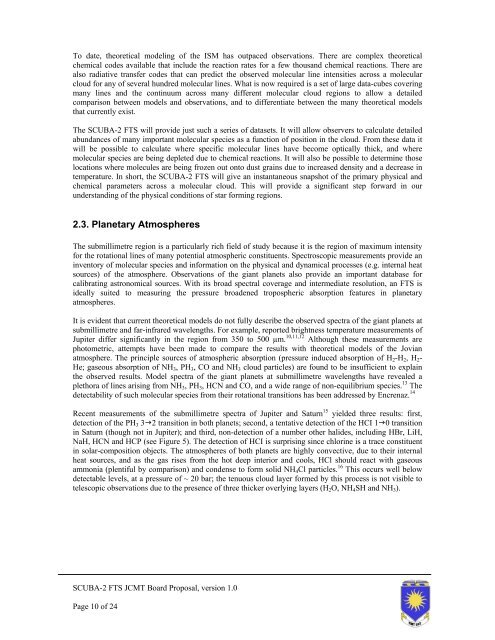Proposal - Research Services - University of Lethbridge
Proposal - Research Services - University of Lethbridge
Proposal - Research Services - University of Lethbridge
Create successful ePaper yourself
Turn your PDF publications into a flip-book with our unique Google optimized e-Paper software.
To date, theoretical modeling <strong>of</strong> the ISM has outpaced observations. There are complex theoretical<br />
chemical codes available that include the reaction rates for a few thousand chemical reactions. There are<br />
also radiative transfer codes that can predict the observed molecular line intensities across a molecular<br />
cloud for any <strong>of</strong> several hundred molecular lines. What is now required is a set <strong>of</strong> large data-cubes covering<br />
many lines and the continuum across many different molecular cloud regions to allow a detailed<br />
comparison between models and observations, and to differentiate between the many theoretical models<br />
that currently exist.<br />
The SCUBA-2 FTS will provide just such a series <strong>of</strong> datasets. It will allow observers to calculate detailed<br />
abundances <strong>of</strong> many important molecular species as a function <strong>of</strong> position in the cloud. From these data it<br />
will be possible to calculate where specific molecular lines have become optically thick, and where<br />
molecular species are being depleted due to chemical reactions. It will also be possible to determine those<br />
locations where molecules are being frozen out onto dust grains due to increased density and a decrease in<br />
temperature. In short, the SCUBA-2 FTS will give an instantaneous snapshot <strong>of</strong> the primary physical and<br />
chemical parameters across a molecular cloud. This will provide a significant step forward in our<br />
understanding <strong>of</strong> the physical conditions <strong>of</strong> star forming regions.<br />
2.3. Planetary Atmospheres<br />
The submillimetre region is a particularly rich field <strong>of</strong> study because it is the region <strong>of</strong> maximum intensity<br />
for the rotational lines <strong>of</strong> many potential atmospheric constituents. Spectroscopic measurements provide an<br />
inventory <strong>of</strong> molecular species and information on the physical and dynamical processes (e.g. internal heat<br />
sources) <strong>of</strong> the atmosphere. Observations <strong>of</strong> the giant planets also provide an important database for<br />
calibrating astronomical sources. With its broad spectral coverage and intermediate resolution, an FTS is<br />
ideally suited to measuring the pressure broadened tropospheric absorption features in planetary<br />
atmospheres.<br />
It is evident that current theoretical models do not fully describe the observed spectra <strong>of</strong> the giant planets at<br />
submillimetre and far-infrared wavelengths. For example, reported brightness temperature measurements <strong>of</strong><br />
Jupiter differ significantly in the region from 350 to 500 µm. 10,11,12 Although these measurements are<br />
photometric, attempts have been made to compare the results with theoretical models <strong>of</strong> the Jovian<br />
atmosphere. The principle sources <strong>of</strong> atmospheric absorption (pressure induced absorption <strong>of</strong> H2-H2, H2-<br />
He; gaseous absorption <strong>of</strong> NH3, PH3, CO and NH3 cloud particles) are found to be insufficient to explain<br />
the observed results. Model spectra <strong>of</strong> the giant planets at submillimetre wavelengths have revealed a<br />
plethora <strong>of</strong> lines arising from NH3, PH3, HCN and CO, and a wide range <strong>of</strong> non-equilibrium species. 13 The<br />
detectability <strong>of</strong> such molecular species from their rotational transitions has been addressed by Encrenaz. 14<br />
Recent measurements <strong>of</strong> the submillimetre spectra <strong>of</strong> Jupiter and Saturn 15 yielded three results: first,<br />
detection <strong>of</strong> the PH3 32 transition in both planets; second, a tentative detection <strong>of</strong> the HCI 10 transition<br />
in Saturn (though not in Jupiter); and third, non-detection <strong>of</strong> a number other halides, including HBr, LiH,<br />
NaH, HCN and HCP (see Figure 5).<br />
The detection <strong>of</strong> HCI is surprising since chlorine is a trace constituent<br />
in solar-composition objects. The atmospheres <strong>of</strong> both planets are highly convective, due to their internal<br />
heat sources, and as the gas rises from the hot deep interior and cools, HCl should react with gaseous<br />
ammonia (plentiful by comparison) and condense to form solid NH4Cl particles. 16 This occurs well below<br />
detectable levels, at a pressure <strong>of</strong> ~ 20 bar; the tenuous cloud layer formed by this process is not visible to<br />
telescopic observations due to the presence <strong>of</strong> three thicker overlying layers (H2O, NH4SH and NH3).<br />
SCUBA-2 FTS JCMT Board <strong>Proposal</strong>, version 1.0<br />
Page 10 <strong>of</strong> 24
















